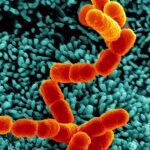Lien vers Pubmed [PMID] – 1846078
Am. J. Respir. Cell Mol. Biol. 1991 Jan;4(1):65-71
Cotton bract tannin is a potent stimulus for platelet aggregation and secretion. Tannin has been shown to stimulate the phosphorylation of two 19-kD and 47-kD cytosolic proteins in platelets, but earlier steps in signal transducing mechanisms of platelet activation are unknown. In this study, measurements of 32P-labeled phospholipids, 14C-labeled arachidonic acid, and levels of intracellular free calcium (Ca2+) were performed before and after the addition of thrombin (1 U/ml) or various concentrations of tannin to human platelets. The results showed that tannin induced a dose-dependent synthesis of phosphatidic acid, an early and transient hydrolysis of phosphatidylinositol monophosphate and bisphosphate, a transient synthesis of diacylglycerol, and a release of arachidonic acid metabolites. The kinetics of phosphatidic acid, diacylglycerol, and arachidonic acid metabolite synthesis were similar after platelet stimulation by tannin (75 micrograms/ml) or thrombin. Tannin also induced a reversible rise of intracellular Ca2+ due to a mobilization of the internal stores and an influx of extracellular Ca2+. These results suggest that cotton bract tannin, as thrombin, activates human platelets by phospholipase C and A2 activations, release of diacylglycerol, and mobilization of intracellular free Ca2+.

